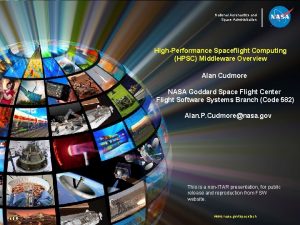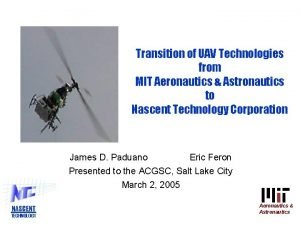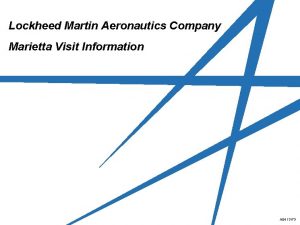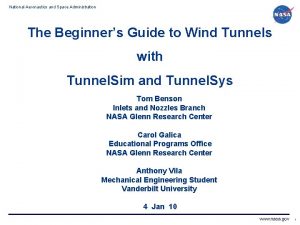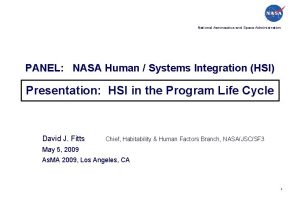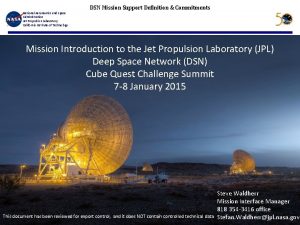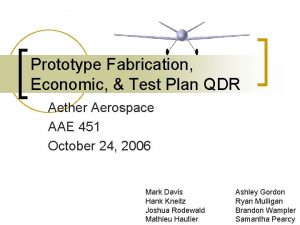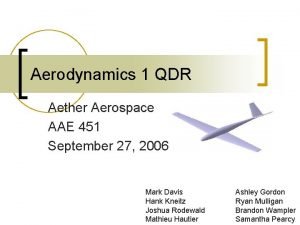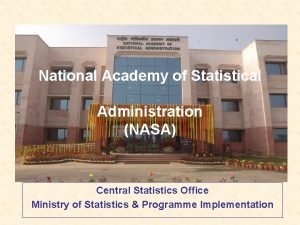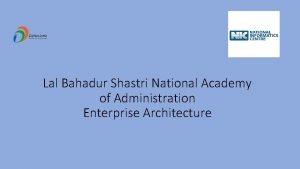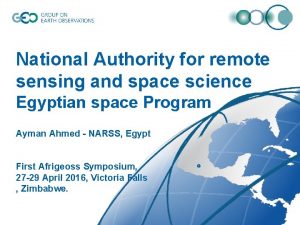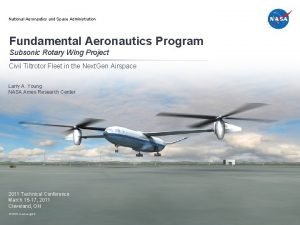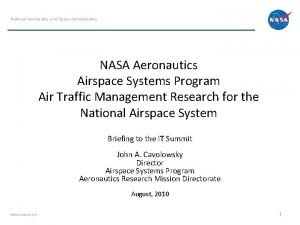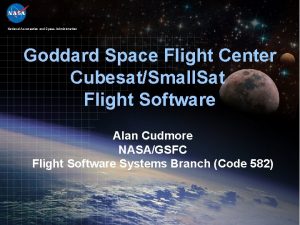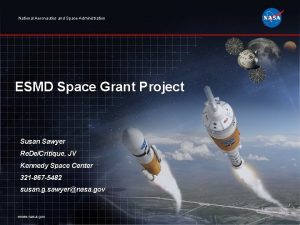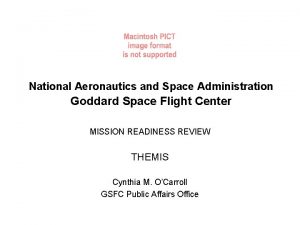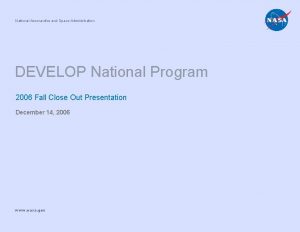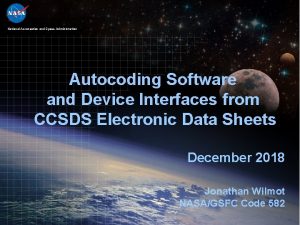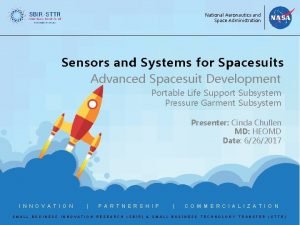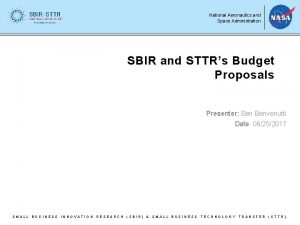National Aeronautics and Space Administration HighPerformance Spaceflight Computing





























- Slides: 29

National Aeronautics and Space Administration High-Performance Spaceflight Computing (HPSC) Middleware Overview Alan Cudmore NASA Goddard Space Flight Center Flight Software Systems Branch (Code 582) Alan. P. Cudmore@nasa. gov This is a non-ITAR presentation, for public release and reproduction from FSW website. www. nasa. gov/spacetech This is a non-ITAR presentation, for public release and reproduction from FSW website.

Agenda • • • High Performance Spacecraft Computing (HPSC) Overview HPSC Contract HPSC Chiplet Architecture HPSC System Software HPSC Middleware NASA HPSC Use Cases HPSC Ecosystem Summary/Status This is a non-ITAR presentation, for public release and reproduction from FSW website. 2

High Performance Spaceflight Computing (HPSC) Overview • The goal of the HPSC program is to dramatically advance the state of the art for spaceflight computing • HPSC will provide a nearly two orders-of-magnitude improvement above the current state of the art for spaceflight processors, while also providing an unprecedented flexibility to tailor performance, power consumption, and fault tolerance to meet widely varying mission needs • These advancements will provide game changing improvements in computing performance, power efficiency, and flexibility, which will significantly improve the onboard processing capabilities of future NASA and Air Force space missions • HPSC is funded by NASA’s Space Technology Mission Directorate (STMD), Science Mission Directorate (SMD), and the United States Air Force • The HPSC project is managed by Jet Propulsion Laboratory (JPL), and the HPSC contract is managed by NASA Goddard Space Flight Center (GSFC) This is a non-ITAR presentation, for public release and reproduction from FSW website. 3

HPSC Contract • Following a competitive procurement, the HPSC cost-plus fixed-fee contract was awarded to Boeing • Under the base contract, Boeing will provide: § Prototype radiation hardened multi-core computing processors (Chiplets), both as bare die and as packaged parts § Prototype system software which will operate on the Chiplets § Evaluation boards to allow Chiplet test and characterization § Chiplet emulators to enable early software development • Five contract options have been executed to enhance the capability of the Chiplet § On-chip Level 3 cache memory § Added a real-time processing subsystem containing two lockstepable ARM R-class processors and a single ARM A-class processor § Triple Time Triggered Ethernet (TTE) interfaces § Dual Space. Wire interfaces § Package amenable to spaceflight qualification • Contract deliverables are due April 2021 This is a non-ITAR presentation, for public release and reproduction from FSW website. 4

HPSC Chiplet Architecture This is a non-ITAR presentation, for public release and reproduction from FSW website. 5

HPSC Chiplet Architecture Timing, Reset, Config & Health Controller (TRCH) Triple Modular Redundant low power ARM M 4 F core for configuration, health and status, and fault monitoring This is a non-ITAR presentation, for public release and reproduction from FSW website. 6

HPSC Chiplet Architecture Real Time Processing Subsystem (RTPS) • Dual lockstep R 52 ARM v 8 -R (600 Mhz) • Three 1 MB Tightly Coupled Memories (TCM) • FPU and NEON SIMD • Single A 53 ARM v 8 compliant cores(600 Mhz) • A 53 w/512 KB Level 2, 32 KB Instruction & 32 KB Data cache • FPU and NEON SIMD • Separate PCIe and DDR 3/DDR 4 interfaces This is a non-ITAR presentation, for public release and reproduction from FSW website. 7

HPSC Chiplet Architecture High Performance Processing Subsystem (HPPS) • 8 A 53 ARM v 8 compliant cores (800 Mhz) • Shared 4 MB L 3 cache • Quad shared 2 MB L 2 x 2 • Per core 64 KB Instruction & 64 KB Data cache • Includes FPU and NEON SIMD This is a non-ITAR presentation, for public release and reproduction from FSW website. 8

HPSC Chiplet Architecture • 3 -DDR 3/4 interfaces(800 Mhz) • can be populated with DDR and/or MRAM • 2 -NAND/NOR/SRAM/MRAM interfaces • (not shown) This is a non-ITAR presentation, for public release and reproduction from FSW website. 9

HPSC Chiplet Architecture High Speed I/O • 6 SRIO high speed interfaces w/4 lanes per port for 41. 24 Gb/s per port • Total of 59. 1 GB/s of IO bandwidth • Embedded s. RIO switch with 2 internal endpoints • 2 Gen 2 PCIe ports at 2 lanes per port 10 Gb/s per port • Total of 20 Gb/s of IO bandwidth • 3 Time Triggered Ethernet ports at 10/1000 Mb/s each • 2 Space. Wire ports at 400 Mb/s each • 1 general purpose Ethernet port at 10/1000 Mb/s This is a non-ITAR presentation, for public release and reproduction from FSW website. 10

HPSC Chiplet Architecture Low Speed I/O • Non-volatile memory • JTAG • UART • I 2 C • SPI • 64 general purpose I/O This is a non-ITAR presentation, for public release and reproduction from FSW website. 11

HPSC Chiplet Architecture Fault Tolerance and Debug Features HW based fault tolerance • EDAC, scrubbing • TMR of critical logic • ARM Trust. Zone • Access isolation regions ARM Coresight debug and trace subsystem This is a non-ITAR presentation, for public release and reproduction from FSW website. 12

HPSC System Software • • The HPSC Chiplet will be delivered with a complement of prototype system software developed by Boeing subcontractor University of Southern California/Information Sciences Institute (USC/ISI) The System Software leverages a large complement of existing open source software including: § § • The System Software consists of: 1. 2. 3. 4. 5. 6. • Libraries, operating systems, compilers, debuggers, and simulators. Much of the software will be unmodified. Board support packages for Linux and RTEMS Development tools (e. g. , compilers, debuggers, IDEs) Chiplet Configuration APIs Mailbox API Software-based fault tolerance libraries Chiplet emulators The goal is to build a sustainable software ecosystem to enable full lifecycle software development. This is a non-ITAR presentation, for public release and reproduction from FSW website. 13

HPSC System Software TRCH Config Management Config Mgmt System Software APIs Fault Detection 64 Bit ARM (Aarch 64) Yocto Linux A 53 BSP KVM Hypervisor High Performance Processing Subsystem (HPPS) ARM A 53 Cluster (4) RTEMS Cortex M 4 BSP Chiplet Configuration Manager Subsystem (TRCH) ARM TMR M 4 ARM M 4 System SW APIs Fault Detection RTEMS R 52 BSP Fault Detection (TBD) RTOS A 53 BSP Operating Systems and Chiplet Drivers (RTPS A 53 RTOS is TBD) Real Time Processing Subsystem (RTPS) ARM R 52 ARM A 53 This is a non-ITAR presentation, for public release and reproduction from FSW website. Chiplet Hardware 14

1 1 / 2 2 / • 2 0 HPSC System Software HPSC Reference Board Support Package (BSP) Features: § TRCH Cortex-M 4 will execute RTEMS with support for: • SRIO, low speed I/O, configuration registers, windowed-access into all memories. • RTPS Cortex-R 52 will execute RTEMS with support for: • SRIO, PCIe, Spacewire, TTE, low speed I/O, RTPS DDR, windowed access into HPPS DDR, NVRAM. • HPPS Cortex-A 53 clusters will execute Yocto Linux with support for: • SRIO, PCIe, Spacewire, Ethernet, TTE, HPPS DDR, NVRAM • HPSC Chiplet supports running Linux, which makes available a rich and familiar development environment. This improves efficiency of software development in particular for science applications § Many science applications already start off development in Linux only to be ported to a different OS. With HPSC, no extra porting step is required, saving effort and reducing risk This is a non-ITAR presentation, for public release and reproduction from FSW website. 15

HPSC Fault Isolation Real Time Processing Subsystem (RTPS) High Performance Processing Subsystem (HPPS) KVM Hypervisor High Performance Data Processing Software AI, Vision processing, etc • • Software Fault Subsystem Isolation Linux on A 53 clusters R 52 cores A 53 Real-time Mission Critical software The HPSC Chiplet ensures that misbehavior in HPPS cannot interfere with critical functions in the RTPS • The HPSC Chiplet provides a Trusted Computing Base (TCB) that is small relative to the overall capability of the system. • For example, a minimal TCB would consist of flight control, communications, health monitor, and software update management running on the RTOS. These high criticality functions remain safely isolated from any misbehavior in Linux One of many potential examples of fault isolation in the HPSC • Other examples include the use of a hypervisor or partitioned OS on the HPPS This is a non-ITAR presentation, for public release and reproduction from FSW website. 16

HPSC Middleware • The Air Force Research Laboratory (AFRL) is funding NASA Jet Propulsion Laboratory (JPL) and NASA Goddard Space Flight Center (GSFC) to develop HPSC Middleware • HPSC Middleware will provide a software layer that provides services to the higher-level application software to achieve: § § Configuration management Resource allocation Power/performance management Fault tolerance capabilities of the HPSC chiplet • Serving as a bridge between the upper application layer and lower operating system or hypervisor, the middleware will significantly reduce the complexity of developing applications for the HPSC Chiplet This is a non-ITAR presentation, for public release and reproduction from FSW website. 17

HPSC Middleware Mission Flight Software Applications Middleware On HPPS A 53 s Middleware On RTPS R 52 Mission FSW Middleware On RTPS A 53 Middleware Config Mgmt Fault Detection System Software APIs 64 Bit ARM (Aarch 64) Yocto Linux A 53 BSP High Performance Processing KVM Hypervisor Subsystem (HPPS) ARM A 53 Cluster Fault Detection RTEMS Cortex M 4 BSP RTEMS R 52 BSP Chiplet Configuration Manager Subsystem (TRCH) ARM M 4 TMR M 4 ARM M 4 System Software (TBD) RTOS A 53 BSP Real Time Processing Subsystem (RTPS) ARM R 52 ARM A 53 This is a non-ITAR presentation, for public release and reproduction from FSW website. Chiplet Hardware 18

Middleware Functions • The HPSC Middleware provides the following key functions: § § § Boot and Load Services Chiplet Configuration Management Chiplet Resource Allocation and Management Chiplet Power and Performance Management Fault Tolerance and Redundancy Management Messaging Services • These functions are implemented through 13 Middleware Services This is a non-ITAR presentation, for public release and reproduction from FSW website. 19

Middleware Services (1 of 2) • Middleware functions are provided by the following services 1. Deployment and Multicore Programming Services • Deployment of time critical vs computational intensive applications to RTPS & HPPS • Thread creation and assignment to specific processing cores for execution • Utilize multicore environment to establish parallel processing capability • Utilize Linux/MPI features • Utilize Open. MP library for multicore programming functions 2. Machine Information Services • Get information about cores, clusters, chiplets, and system 3. Resource Management/Arbitration Services • Manage configuration files and assign available resources to software clients 4. Memory Management Services • MMU configuration, memory allocation to applications 5. Interrupt Services • Configure Interrupt controller to route interrupts to specific cores at runtime 6. Timing Services • Establish, synchronize, and distribute time This is a non-ITAR presentation, for public release and reproduction from FSW website. 20

Middleware Services (2 of 2) 7. Messaging Services • Send/receive messages between tasks on the same or different cores and Chiplets 8. Power Management Services • Power on/off setting for cores/clusters/Chiplets, and set clock rates 9. Debug and Trace Services • Support the interface for software debugging during development • Support the capability for performance metrics collection during execution 10. Boot and Load Process and System Configuration Services • Provide an Initial Program Loader (IPL) and support various boot types/processes 11. Peripheral IO Services • Allocate and configure Chiplet Peripheral I/O to software clients 12. Multi-Chiplet Management Services • Configure and manage Inter-Chiplet interfaces (e. g. , boot, messaging, resources) 13. Fault and Redundancy Management Services • Fault detection (HW/SW faults) and recovery This is a non-ITAR presentation, for public release and reproduction from FSW website. 21

HPSC Use Cases – Rovers and Landers Rover Lander This is a non-ITAR presentation, for public release and reproduction from FSW website. 22

HPSC Use Cases - High Bandwidth Instruments and Small. Sats/Constellations High Bandwidth Instrument Smallsat This is a non-ITAR presentation, for public release and reproduction from FSW website. 23

HPSC Use Cases – Human Exploration and Operations (HEO) Habitat/Gateway Notional Two Fault Tolerant System Sensors (Cameras, Lidars, etc. ) FCR FCR TTGb. E x 3 This is a non-ITAR presentation, for public release and reproduction from FSW website. 24

Broader HPSC Ecosystem • Beyond the HPSC Chiplet, System Software, and Middleware developments, further investments can implement a robust HPSC avionics ecosystem § § § § Advanced Spaceflight Memory Increased RTOS Support Multi-Output Point-Of-Load Converters Coprocessors (GPU, Neuromorphic, etc. ) Special Purpose Chiplets (Security Chiplet, etc. ) Advanced Packaging (Multiple Chiplets in a Package) Single Board Computers This is a non-ITAR presentation, for public release and reproduction from FSW website. 25

Conclusion/Status • Conclusion § As illustrated by the NASA use cases, our future missions demand the capabilities of HPSC § Improved spaceflight computing means enhanced computational performance, energy efficiency, and fault tolerance § With the ongoing HPSC development, we are well underway to meeting future spaceflight computing needs § The NASA-developed Middleware will allow the efficient infusion of the HPSC Chiplet into those missions § Further investments can implement a full HPSC avionics ecosystem • Status § USC/ISI delivered System Software Release 1. 0 at the May 2018 HPSC Preliminary Design Review • Consists of a QEMU based software emulator and initial Yocto Linux based software development kit § The NASA JPL and GSFC HPSC Middleware team will complete Middleware release R 1 this month (December 2018) • Middleware release R 1 consists of a subset of the services, mostly targeting A 53 Linux functionality while the hardware is being developed Acknowledgements: Wes Powell (GSFC), Rich Doyle (JPL), Rafi Some (JPL), Jim Butler (JPL), Irene Bibyk (GSFC), Jonathan Wilmot (GSFC), John Lai (JPL), J. P. Walters (USC/ISI), and Jon Ballast (Boeing) for diagrams and use case definitions. This is a non-ITAR presentation, for public release and reproduction from FSW website. 26

Acronyms (1) Acronym Meaning AFRL Air Force Research Laboratory FPGA Field programmable Gate Array AMBA Advanced Microcontroller Bus Architecture GNC Guidance Navigation and Control API Application Programmer Interface GOPS Giga Operations Per Second ARM Advanced RISC Machines GPIO General Purpose Input Output BIST Built In Self Test GPU Graphics Processing Unit BSP Board Support Package GSFC Goddard Space Flight Center C&DH Command Data Handling HEO Human Exploration and Operations CPU Central Processing Unit HPPS High Performance Processing Subsystem DDR Double Data Rate HPSC High Performance Spacecraft Computing DMIPS Dhrystone Millions of Instructions per Second HW Hardware DMR Dual Modular Redundancy I/O Input / Output DRAM Dynamic Random Access Memory I 2 C Inter-Integrated Circuit FCR Fault Containment Region IDE Integrated Development Environment This is a non-ITAR presentation, for public release and reproduction from FSW website. 27

Acronyms (2) Acronym Meaning IPL Initial Program Loader NVRAM Non Volatile Random Access Memory ISA Instruction Set Architecture PCIe Peripheral Component Interconnect express ISI Information Sciences Institute QEMU Quick Emulator ITAR International Traffic In Arms Regulations RTEMS Real Time Executive for Multiprocessor Systems JPL Jet Propulsion Laboratory RTOS Real Time Operating System KVM Kernel Based Virtual Machine RTPS Real Time Processing Subsystem MIPS Millions of Instructions per Second SCP Self Checking Pair MMU Memory Management Unit SIMD Single Instruction Multiple Data MPI Message Passing Interface SMD Science Mission Directorate MRAM Magnetoresistive Random Access Memory SPI Serial Peripheral Interface NAND NOT-AND logic SPW Spacewire NASA National Aeronautics and Space Administration SRAM Static Random Access Memory NEON Single Instruction Multiple Data architecture SRIO Serial Rapid Input Output This is a non-ITAR presentation, for public release and reproduction from FSW website. 28

Acronyms (3) Acronym Meaning Acronym SSR Solid State Recorder STMD Space Technology Mission Directorate SW Software TBD To Be Determined TMR Triple Modular Redundancy TRCH Timing, Reset, Configuration, and Health TTE Time Triggered Ethernet UART Universal Asynchronous Receiver Transmitter USC University of Southern California VMC Vehicle Management Computer Meaning This is a non-ITAR presentation, for public release and reproduction from FSW website. 29
 National aeronautics and space administration
National aeronautics and space administration Debris assessment software
Debris assessment software High performance spaceflight computing
High performance spaceflight computing Mit aeronautics and astronautics
Mit aeronautics and astronautics Pioneer astronautics internship
Pioneer astronautics internship What was the first tool of aeronautics to be developed?
What was the first tool of aeronautics to be developed? Martin marietta aeronautics
Martin marietta aeronautics Tdot aeronautics
Tdot aeronautics Lm aero
Lm aero Define aeronautics
Define aeronautics Beginner's guide to aeronautics
Beginner's guide to aeronautics Hsi
Hsi Aeronautics definition
Aeronautics definition Balloon (aeronautics)
Balloon (aeronautics) Aether aeronautics
Aether aeronautics Maximum lift coefficient formula
Maximum lift coefficient formula Conventional computing and intelligent computing
Conventional computing and intelligent computing National academy for public administration
National academy for public administration National academy of statistical administration
National academy of statistical administration National highway safety administration reviews
National highway safety administration reviews National cemetery administration
National cemetery administration Lal bahadur shastri national academy of administration
Lal bahadur shastri national academy of administration National space research and development agency
National space research and development agency National authority for remote sensing and space sciences
National authority for remote sensing and space sciences What is nceac
What is nceac National unification and the national state
National unification and the national state Cartesian space trajectory planning
Cartesian space trajectory planning Space junk the space age began
Space junk the space age began Camera space to world space
Camera space to world space Unscented trajectory chapter 5
Unscented trajectory chapter 5


